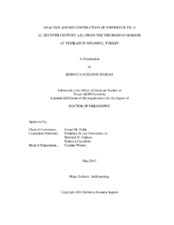| dc.description.abstract | Since 2004, the Istanbul Archaeological Museums have conducted salvage archaeological excavations at the construction site of an underground railway station at Yenikapı in Istanbul, Turkey. These excavations have unearthed the remains of Constantinople’s Theodosian Harbor (Portus Theodosiacus), including 36 Byzantine shipwrecks. The detailed study of eight of these wrecks was allocated to a small international team under the direction of Cemal Pulak from the Institute of Nautical Archaeology (INA) at Texas A&M University. One of these shipwrecks, YK 11, was a small, heavily-repaired, pine-built merchantman abandoned as a derelict at the western end of the harbor early in the seventh century. This dissertation serves as a detailed record of the YK 11 hull remains, provides a theoretical reconstruction of the vessel, compares the ship’s construction with that of contemporaneous vessels, and explores the ship’s historical context.
The YK 11 hull was excavated, dismantled, and removed from the construction zone at Yenikapı in 2008. The author conducted the post-excavation documentation of the ship’s timbers between 2009 and 2012, following methods established by Fred van Doorninck and J. Richard Steffy of INA in their work with Mediterranean shipwrecks. This documentation revealed that YK 11 had undergone a series of significant repairs over the ship’s lifetime. In these repairs, much of the ship’s original planking, edge fastened with unpegged mortise-and-tenon joints below the waterline, was replaced with planks lacking edge fasteners; a considerable number of the ship’s frames were also replaced. These repairs to YK 11 significantly complicated the interpretation of its original construction.
The paucity of edge fasteners, presence of caulking, and attachment of frames to the keel might be taken as evidence that YK 11 was built after a skeleton-based tradition. However, with the detailed documentation of each component timber, a careful analysis of fastening patterns, the identification of repairs, and a thorough study of the preserved surface detail, it is clear that YK 11, although exhibiting evidence of both shell-first and skeleton-first techniques, was initially designed and built as a primarily shell-based vessel. As such, this study of YK 11 contributes valuable new information toward a better understanding of the transition from shell-based to skeleton-based shipbuilding in the Mediterranean. | en |


